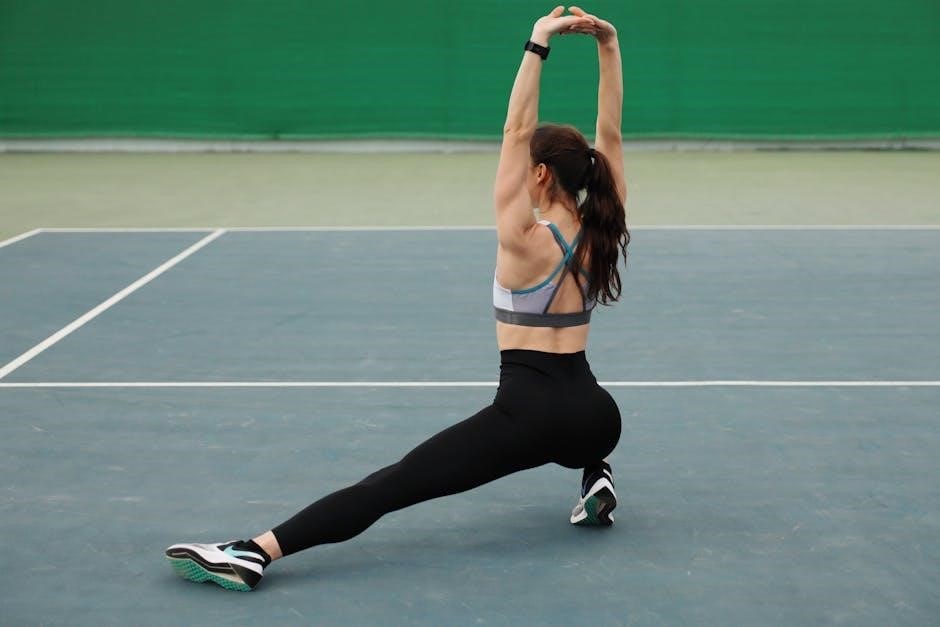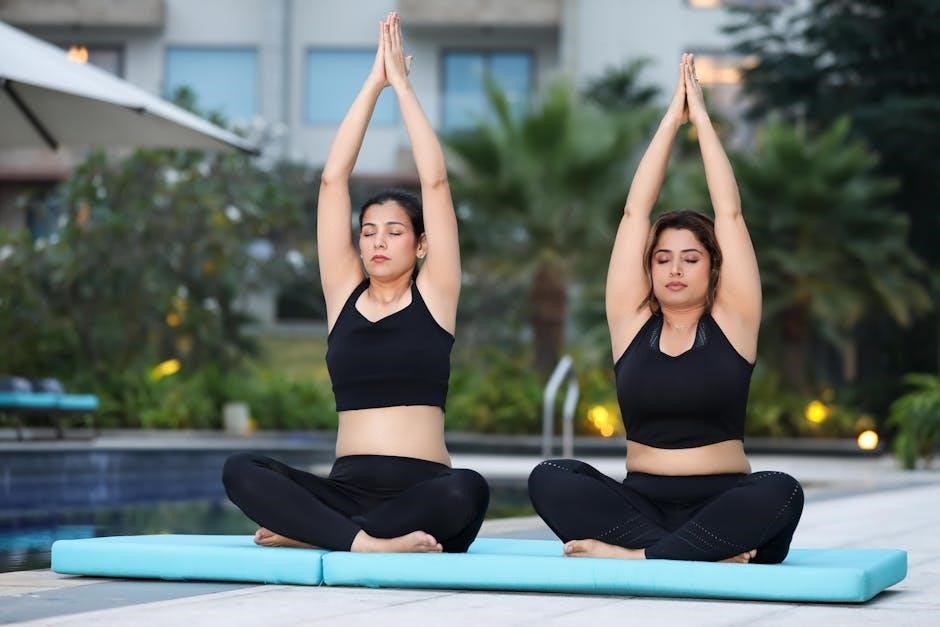
Understanding the Iliopsoas Muscle
The iliopsoas is a powerful muscle group consisting of the iliacus, psoas major, and psoas minor. These muscles are critical for hip flexion and connecting the upper and lower body. They play a key role in movement and pelvic stability.
Anatomy of the Iliopsoas: Psoas Major, Psoas Minor, and Iliacus
The iliopsoas muscle group is comprised of three distinct muscles: the psoas major, psoas minor, and iliacus. The psoas major is a large muscle that originates from the lumbar vertebrae and engages in almost any movement, including walking and running. The psoas minor, a thinner muscle, lies on the front of the psoas major. The iliacus muscle originates from the iliac fossa and merges with the psoas major to insert on the femur. Together, these muscles are vital for hip flexion and pelvic stabilization.

Importance of Iliopsoas Stretches
Iliopsoas stretches are essential for maintaining flexibility and function. They address tightness that can lead to lower back pain and hip issues, promoting overall mobility and well-being in daily life.
Connecting Upper and Lower Body
The iliopsoas muscle group uniquely connects the upper and lower body, making it vital for integrated movement. As the only muscle group bridging these regions, the iliopsoas influences posture and biomechanics. When the iliopsoas becomes tight or dysfunctional, it can restrict movement patterns affecting both the upper and lower body. Stretching helps restore optimal function, allowing for smoother, more efficient movement and improved kinetic chain integration. Regular iliopsoas stretches facilitate better communication and coordination between the body’s upper and lower halves. This ensures a balanced distribution of force and reduces the risk of injury.
Role in Movement and Pelvic Stability
The iliopsoas plays a crucial role in various movements, including walking, running, and even sitting. As a primary hip flexor, it initiates leg movement and supports proper posture. Furthermore, the iliopsoas significantly contributes to pelvic stability by acting as a dynamic stabilizer. This muscle group helps maintain the pelvis’s neutral alignment, preventing excessive tilting or rotation. A balanced and flexible iliopsoas ensures efficient movement patterns and reduces strain on the lower back and hips. Regular stretching helps preserve its function, promoting stability and minimizing the risk of compensatory movements that could lead to pain or injury.
Benefits of Stretching the Iliopsoas
Stretching the iliopsoas offers numerous benefits, including managing tightness, improving flexibility, and releasing tension. Regular stretching promotes optimal muscle function, reduces lower back strain, and enhances overall mobility for daily activities.
Managing Iliopsoas Issues
Iliopsoas issues, such as tightness or pain, can be effectively managed through consistent stretching and strengthening exercises. A dedicated stretching routine, performed 2-3 times daily, helps keep the hip muscles limber and prevents them from becoming overly tight. Addressing iliopsoas problems involves power to breath, relax, feel the tension, and let it go. Combining stretching with strengthening exercises is key for long-term relief and improved function.
Improving Flexibility
Regular iliopsoas stretches are essential for enhancing overall flexibility. Stretching helps lengthen the muscle fibers, increasing range of motion in the hips and lower back. Improved flexibility not only aids in physical activities but also reduces the risk of injury. By consistently stretching, you can unlock a greater freedom of movement. It contributes to better posture and alleviates tension throughout the body, facilitating everyday tasks with ease and comfort.
Iliopsoas Stretches: Step-by-Step Instructions
Effective iliopsoas stretches include the kneeling hip stretch, table stretch, and stretches using a ball for support. Each offers unique benefits and targets different aspects of the muscle group for optimal results.
Kneeling Hip Stretch
Begin in a kneeling position, placing one foot forward with your knee bent at 90 degrees. Gently lean forward, feeling a stretch in the front of your hip and thigh. Ensure your back remains straight. Hold the stretch, breathing deeply to relax the muscles. This stretch targets the iliopsoas, improving flexibility and reducing tightness. Repeat on both sides, being mindful of any discomfort or pain. Use padding under your knee if needed for comfort.
Iliopsoas Stretch (Table)
Lie on your back near the edge of a table or bed. Let one leg hang off the edge while pulling the opposite knee towards your chest. This position allows gravity to assist in stretching the iliopsoas muscle. You should feel a stretch in the front of your hip and thigh of the hanging leg. Maintain a relaxed posture and breathe deeply throughout the stretch. Avoid any sharp or intense pain. This stretch effectively targets the iliopsoas, promoting flexibility.
Hip Flexor Stretches with Ball
Begin in a lunge position with your back knee resting on the floor, using a pad for comfort if needed. Place your hands on a chair or stability ball for support. Gently lean forward, keeping your upper body upright. You should feel a stretch in the front of your hip and thigh. The ball provides added stability and allows for a deeper stretch. Ensure you breathe deeply and maintain a controlled movement. This targets the psoas, iliacus, and quadriceps muscles, enhancing hip flexibility.

Proper Technique and Precautions
When performing iliopsoas stretches, proper technique is essential. Focus on breathing and relaxation to maximize the stretch. It’s crucial to avoid pain and injury by listening to your body and not pushing too hard.
Breathing and Relaxation Techniques
Effective breathing and relaxation are crucial for maximizing the benefits of iliopsoas stretches. Deep, controlled breaths help release tension in the muscle and surrounding tissues. Focus on inhaling deeply, allowing your abdomen to expand, and exhaling slowly to promote relaxation. Visualization techniques, such as imagining the muscle lengthening and softening, can also enhance the stretch. Practicing mindfulness and staying present in your body will help prevent overstretching and injury. Remember to breathe throughout each stretch, avoiding holding your breath. This helps the muscles to release and relax.
Avoiding Pain and Injury
When performing iliopsoas stretches, it’s essential to prioritize safety to avoid pain and injury. Listen to your body and stop if you feel any sharp or intense pain. Gradual progression is key; avoid forcing yourself into a deeper stretch than your body is ready for. Maintain proper form and alignment during each stretch to prevent strain. If you have any pre-existing conditions, consult with a healthcare professional before starting a new stretching routine. Use padding or support when needed, especially during kneeling stretches. Remember, the goal is to gently release tension, not to cause discomfort.

Frequency and Timing of Stretches
To maintain flexibility, a good iliopsoas stretching routine should be performed 2-3 times a day. Stretching in the morning and evening can help keep your hip muscles limber and prevent tightness.
Recommended Stretching Routine: 2-3 Times Daily
Incorporating a consistent stretching routine is crucial for managing iliopsoas issues and maintaining optimal hip flexibility. Performing stretches 2-3 times daily helps prevent the hip muscles from becoming too tight. Regular stretching is essential, especially if you experience tightness or discomfort in your hip flexors. Consistency is key to improving and maintaining flexibility, ensuring the iliopsoas muscle remains limber and functional. This frequency allows for regular release of tension, improving overall movement and stability.
Best Times to Stretch: Morning and Evening
Stretching the iliopsoas at specific times of the day can maximize its benefits. Stretching in the morning helps to loosen the muscles after a night of inactivity, improving mobility for the day ahead. Evening stretches can relieve tension accumulated throughout the day, promoting relaxation and better sleep. Incorporating stretches at both times ensures consistent flexibility and helps manage any tightness that may develop. This routine aids in maintaining a limber iliopsoas muscle, contributing to better overall posture and movement patterns.

Strengthening Exercises for the Iliopsoas
Strengthening exercises are crucial for managing iliopsoas issues. Strong muscles support pelvic stability and improve movement patterns. These exercises complement stretching, enhancing overall hip health and function.
Importance of Combining Stretching and Strengthening
Combining stretching and strengthening exercises is vital for optimal iliopsoas health. Stretching increases flexibility and releases tension in tight muscles, while strengthening builds support and stability. This combination addresses both tightness and weakness, common causes of iliopsoas issues. A balanced approach improves muscle function, reduces pain, and prevents future problems, leading to better overall hip and lower back health. Integrating both aspects into a routine ensures comprehensive care.
Additional Resources
For easy access to iliopsoas stretching guides, explore our collection of PDF resources. These guides provide detailed instructions and visual aids to help you perform stretches correctly and safely.
PDF Guides for Easy Access
To further assist you in your iliopsoas stretching journey, we have compiled a range of PDF guides. These resources offer convenient, printable formats that you can easily access at home, at the gym, or on the go. They include detailed instructions, clear diagrams, and helpful tips to ensure you perform each stretch effectively and safely. These guides cover various stretches, including kneeling hip stretches, table stretches, and ball-assisted stretches, providing a comprehensive resource for improving your flexibility and managing iliopsoas issues.